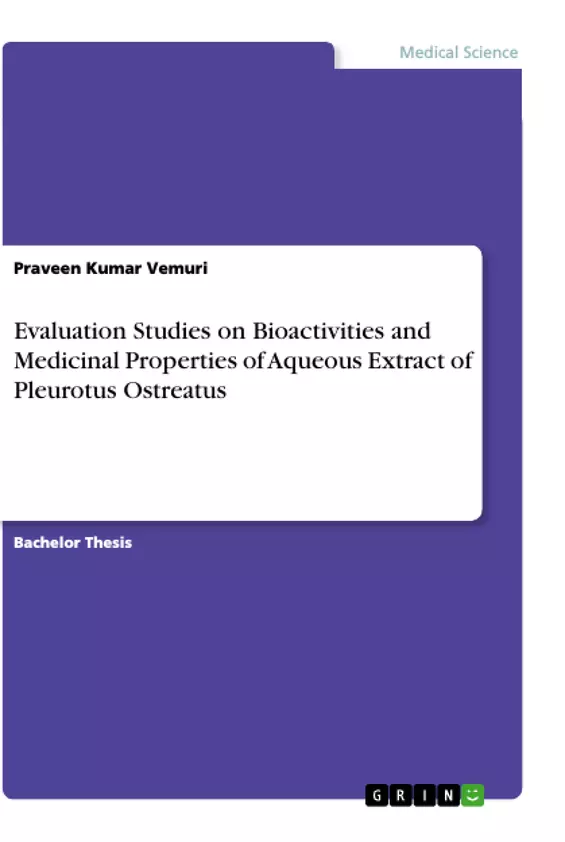Pleurotus ostreatus is primarily an edible mushroom with high nutritional value and biomedical relevance, as it contains numerous bioactive components that generate the development of therapeutic effects. The purpose of this study is to determine the phytopharmacological effects of Pleurotus ostreatus. FT-IR analysis revealed the presence of cycloalkane, nitriles, halogen compounds, aromatic monosubstituted compounds, and carboxyl acid. The presence of 12 bioactive compounds was revealed using gas chromatography-mass spectrometry (GC-MS), and components in the extract were identified and quantified using HPLC. The antimicrobial efficacy of Pleurotus ostreatus aqueous extract against Bacillus megaterium and Bacillus amyloliquifaciens seems promising. The extract’s anticancer efficacy against HeLa and MCF7 at 25 µg/ml and exhibits strong cytotoxicity with an IC50 of 6.8 μg/mL and 17.5 μg/mL respectively.
Inhaltsverzeichnis (Table of Contents)
- 1.0 Introduction
- 2.0 Pleurotus spp. - A Comprehensive Overview
- i. Biodiversity and Taxonomy
- ii. Nutritional Aspects
- iii. Medicinal Properties
- 3.0 Biotechnological Potential of the Genus
- 4.0 Future Perspectives
Zielsetzung und Themenschwerpunkte (Objectives and Key Themes)
This comprehensive overview aims to provide a detailed examination of the genus Pleurotus, focusing on its biodiversity, taxonomy, nutritional value, medicinal properties, and biotechnological potential. The text explores the history and significance of these mushrooms as a food source and explores their growing importance in various scientific and industrial fields.
- Taxonomy and Classification of Pleurotus Species
- Nutritional Profile and Composition of Pleurotus Mushrooms
- Medicinal Properties and Applications of Pleurotus Species
- Biotechnological Potential of Pleurotus for Enzyme Production and Bioremediation
- Emerging Research Areas and Future Perspectives in Pleurotus Studies
Zusammenfassung der Kapitel (Chapter Summaries)
The introduction provides a general overview of mushrooms as a food source and highlights the growing interest in their functional properties, particularly in the context of Pleurotus species. It discusses the importance of these mushrooms and their increasing global production.
Chapter 2 delves into the biodiversity and taxonomy of the Pleurotus genus. It explores the challenges in classifying these species, highlighting the role of molecular techniques in resolving taxonomic disputes. The chapter also discusses the nutritional value of Pleurotus, emphasizing its rich protein content, dietary fiber, and vitamin profile.
Chapter 3 focuses on the biotechnological potential of the genus Pleurotus. It examines its applications in enzyme production, bioremediation, and other industrial processes. The chapter emphasizes the use of molecular techniques for understanding and enhancing the biotechnological capabilities of these mushrooms.
Schlüsselwörter (Keywords)
The key terms and concepts of the text revolve around the genus Pleurotus. The main focus is on the mushrooms' biodiversity, taxonomy, nutritional value, medicinal properties, and biotechnological potential. The discussion includes terms like enzyme production, bioremediation, functional foods, and molecular techniques for species identification and characterization. The text also touches upon topics such as gene editing, RNAi, and genomic analysis of Pleurotus species.
- Quote paper
- Dr Praveen Kumar Vemuri (Author), 2020, Evaluation Studies on Bioactivities and Medicinal Properties of Aqueous Extract of Pleurotus Ostreatus, Munich, GRIN Verlag, https://www.grin.com/document/1156356



